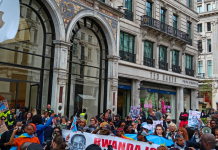The aftermath of Hurricane Harvey isn’t a “natural disaster”, writes Colin Wilson. The misery of millions of people is down to capitalism in general and Trump in particular – all the more reason to fight back against both.

Flooding in Houston is bringing misery to tens of thousands of people, and is set to get significantly worse this week before the rain stops. In some areas over 1m of rain has fallen – and forecasts suggest there is 50cm more to come. Millions of people are stranded in their homes and officials estimate that 30,000 will need shelter. By Monday night 7,000 people had arrived at the single largest shelter – a convention centre with an estimated capacity of only 5,000. 100,000 people have no electricity.
South east Texas has always experienced occasional very heavy rain, but the last few days have been exceptional. When Hurricane Harvey made landfall on Friday, for example, it was the most powerful hurricane in Texas for fifty years. More rain has fallen in the state in the last few days than in any tropical storm in the US since 1978.
Yet the flooding is not just a “natural disaster” that human beings are powerless to prevent. On the contrary, three factors have magnified the human suffering caused by Harvey far beyond what it need have been.
Market-driven urban development
Houston is a boom town – since 2000, the population has increased by a third, rising from 4.7 to 6.5 million people. Those 1.8 million extra people are mostly housed in low-rise suburbs which now sprawl 30 miles from the city centre on what was previously farmland. Land which previously had some capacity to absorb rainwater has been concreted over. So the water travels downstream, into areas which, previously, were relatively safe from flooding.
Lack of public transport exacerbates these problems – Houston’s population is two-thirds that of London, but the city’s rail network covers only 24 miles, compared with 250 miles for the London tube. So most people travel by car, making necessary a motorway network that concretes over more grass-covered prairie with the ability to absorb flood water.
Trump is set to make the situation even worse. He issued an Executive Order earlier this month that abolished flood risk standards for federally-funded infrastructure projects. What is more, he wants to roll out across America the kind of lax building regulations which apply in Houston to structures in potential flood zones.
Climate change
Hurricane Harvey was an exceptionally severe storm – yet “exceptional” weather events are becoming increasingly common. Flooding in 2015 reached levels which Houston’s media described as “historic”. Last year, three waterways in the city reached levels which, it had been calculated, could be expected only once every 500 years. Yet now, a year later, even worse floods are taking place. The cost of dealing with major natural disasters, such as floods and forest fires, has risen five-fold in America since the 1980s.
One reason for flooding across America is climate change – sea levels have increased by 15cm in the last few decades. American government statistics compare the number of flooding incidents in US cities now and in the 1950s – they show a four-fold increase in flooding incidents in Boston, a six-fold increase in Philadelphia and a ten-fold increase in Atlantic City in New Jersey.
A second factor which affects Gulf Coast cities like Houston is the increase in sea temperature. The last few decades have seen an increase of 0.5C. It may not sound like much, but even a small rise increases the energy available to hurricanes as they move across the ocean, and the amount of water vapour they can pick up and dump inland as rain.
With almost 40% of the US population living in high population-density coastal areas, the scale of the potential damage to America’s society and economy is enormous – not in the decades to come, but now and in the next few years. Yet Trump has described global warming as “mythical” and he has pulled America out of the Paris accord.
Class and race
The human cost of the Houston flooding was summarised for many people by a photo of the residents of the La Vita Bella assisted-living home in Dickinson, some 25 miles from central Houston. At least seven elderly people sat waist-deep in brownish water waiting to be rescued – as, finally, they were.
Many people from Houston left the city and drove north as the storm approached. But poorer and disabled residents may not have been able to do so – they might not own a car, or they might not be able to drive it. What’s also clear from maps of Houston is that areas where many people are on low incomes are often areas with high migrant populations, or where lots of people don’t speak English, so that the effects of poverty and racism overlap.
A further aspect of institutional racism in Houston was that the US Border Patrol stated they would continue roadside checks of the immigration status of people fleeing the city in cars. Around 1.4 million people living in Houston were born outside the US, and some 400,000 are undocumented. For these people, fleeing Houston involved the risk of deportation – so that at least some of them will have preferred to stay, despite the horrendous risks.
This contempt on the part of the authorities for the lives of black people, and of poor people, resembles all too closely the events of Hurricane Katrina, 350 miles east along the Gulf Coast in New Orleans. During Katrina, people who were both poor and black suffered disproportionately. Thus, while only 17% of poor whites lacked access to a car, nearly 60% of poor blacks did so, meaning it was mostly low-income black people who were unable to leave when the hurricane hit. But once they had left, typically because their homes were destroyed, they found it impossible to return. A year later, a remarkable 80% of former black residents were still living in other parts of the US with no way of getting back home.
You might assume that the devastation of Katrina would mean that the risk of flooding was now taken seriously as regards low-income housing, at least in New Orleans itself. But – remarkably, shamefully – it isn’t. Almost 2,000 public housing buildings in New Orleans are in flood zones. Across the US, public housing is often built on flood-prone land, because such land is cheap – so that 1 in 20 public housing buildings is at risk from flooding.
What’s the solution?
Any number of short-term solutions would improve the situation in Houston and would have prevented at least some of the damage from occurring. Proper building standards need to be implemented. A major increase in public transport needs to be funded that will stop the endless building of roads. Cities like Houston must put evacuation plans in place that focus, in particular, on the needs of those who cannot leave on their own.
But there remains the wider problem, that of climate change. The Paris accord, though not in itself an effective response to global warming, at least signalled some recognition that it was a problem. So our response to Houston has to involve seeing Harvey as one more reason why Trump has to go, and why a radical movement has to be built that can force real action on climate.
And this brings us to the real root of the problem, which is that a capitalist society is incapable of creating cities which are liveable in the long term for most people, because those in charge are interested in short-term profitability, not sustainability. The alternative has to be planning – not planning in the limited, bureaucratic sense of British or American local government, but a kind of planning which involves the majority of people in informed, lively and democratic debate about to use the resources we have to build a society where human need is what matters, not profit. I’m talking, of course, about socialism. Creating such a society, starting from the currently small forces of the left, is an enormous task. But Houston is one more example of the need for us to do what we can to take that struggle forwards.


















